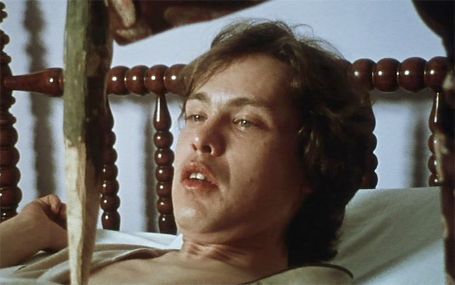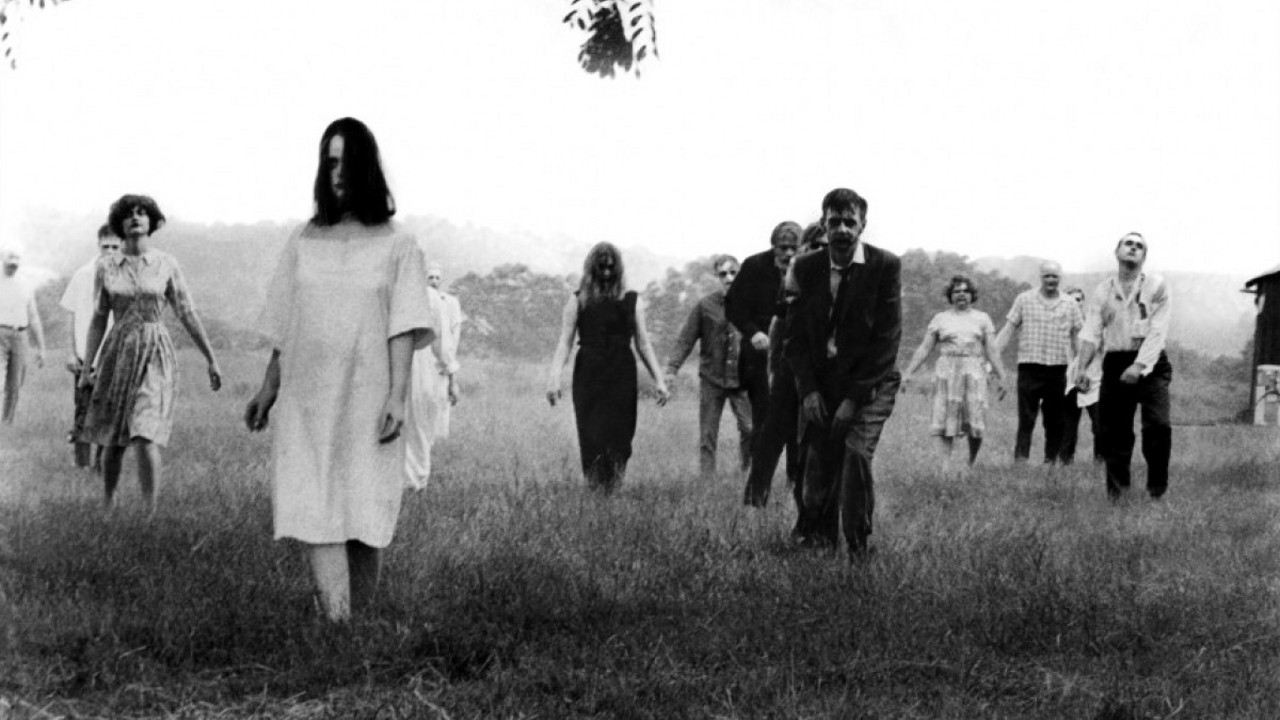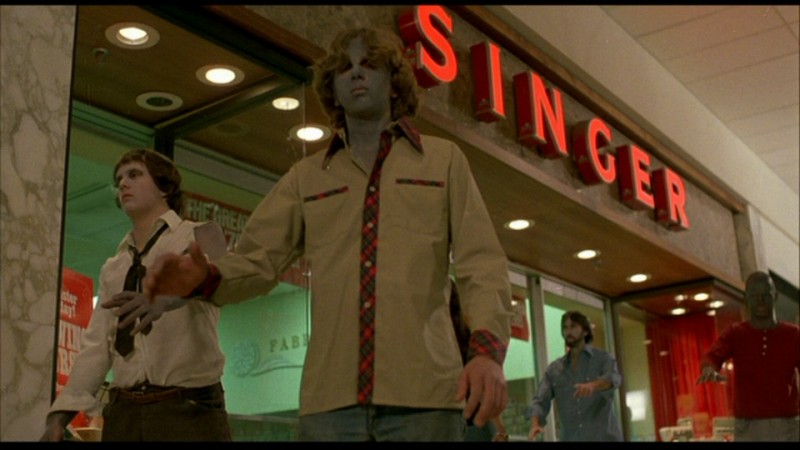3. Martin (1976)
The Plot
Martin is introduced to us on a train ride when he assaults a woman, drugs her and drinks her blood after using a razor blade to cut her open. Martin is clearly a disturbed individual and his problems are not helped by his continuing visions, visions which show him as a cape-wearing vampire similar to the Hammer horror films’ portrayal of the undead.
When Martin arrives at his destination in Pittsburgh, he goes to his new abode, the home of Tateh Cuda and Christine, Martin’s cousin. Tateh actually believes Martin to be a vampire and throughout his stay is constantly on guard, trying to protect Christine and anyone else Martin comes into contact with. He tries to use the traditional vampire repellent methods (garlic, holy water, etc), but they have no effect.
Martin has problems fitting into his new home and starts to phone the local radio station for advice and also to talk about his vampirism. Martin’s thirst is still there, however, and his need for fresh blood continues, with his attacks becoming more brave and aggressive. Will Martin be cured of his illness by Mrs Santini, whom he visits on a regular basis for pleasures of the flesh, or will Tateh’s preventive measures finally work?
Why It’s So Great
Martin focuses on a journey, his own journey, providing us with a brief look into his life. John Amplas’s performance is vital in this movie, more so than in any other of Romero’s movies. This is because Martin leads a disturbed life and we continue to follow him even after we see how disturbed he is.
Romero makes this point clear from the start with an attack on a woman being Martin’s first act in the movie. John portrays Martin as a very confused young man and even after this first attack, we, the audience cannot wait to see what is going to happen to him next. All of Martin’s emotions are conveyed purely through his facial expressions as his role is almost completely without dialogue. There is an element of the original vampire movie Nosferatu here, as Martin silently sneaks around his new surroundings.
The main thrust of this movie is the notion of vampirism. It is clear that Martin gets satisfaction out of his blood-drinking escapades, but whether he actually is a vampire is left up to your imagination. His vivid daydreams of himself as a Christopher Lee styled vampire may make you think he is just a severely troubled person. But if he actually is a vampire, not restrained by the weaknesses the legends suggest he should be (crosses, sunlight, etc.), then these images could actually be memories of his life and not fabricated ideas.
In today’s society if Martin refrained from killing people, he would be welcome in numerous groups that use vampirism as a way of life. He is a man out of time, whether this is because of his problems or he fact he is, in his own words, over 80 years old we do not know. Martin’s actions could be likened to the way a serial killer would operate, particularly his failure to interact with the general public and his tenderness to the corpses of those he has murdered.
Martin’s issues with sexuality could also be a part of his problem. Initially when confronted by the flirty Mrs Santini he runs away, but he has no problem unleashing his sexual lust on his victims. Eventually he does form a relationship with Mrs Santini and it seems to add some stability to his life, so it is shocking when we find out her fate and ironic that it is not Martin’s fault.
There are so many different reasons for Martin’s behaviour, but all we know for sure is that Martin believes he is a vampire. So does Tateh, who takes the role of Van Helsing to Martin’s Count. Tateh’s belief that Martin is evil is an interesting element in the movie. Does this suggest that Martin is a vampire or are Tateh’s religious ideas so strong that he believes it is his religious duty to protect people from Martin the monster? Is Tateh just as confused as Martin?
He is certainly the more aggressive of the two. Martin goes out in secret to satisfy his lustful need for blood, but Tateh is constantly abusing Martin, causing Martin to play childish pranks on him. It is clear that Martin, if he is not a vampire, has problems and Tateh’s constant reinforcing of Martin’s possible fantasies does not help. Romero keeps you guessing throughout the film and an obvious answer is never given, adding to the film’s appeal.
2. Night Of The Living Dead (1968)
The Plot
While visiting their father’s grave, Barbara and Johnny are attacked by a dishevelled and aggressive stranger. Johnny hits his head on a tombstone and appears to die. During this chaos, Barbara manages to flee. But while escaping from the crazed man, she crashes her car in a panic. Barbara is forced to stay at a farmhouse close by when, much like her experience in the graveyard, she is confronted by strange people who try to assault her.
A gentleman called Ben arrives to help Barbara fight off the hordes, and they retreat into the farmhouse and go about boarding it up. During this commotion, a group of people emerge from the cellar where they had been hiding out. This group is comprised of the confrontational Harry Cooper and his wife Helen who have a child called Karen who is recovering from an attack. There is also a young couple called Tom and Judy.
Issues soon arise within the group with Ben and Harry constantly getting in each other’s way. The tension rises even further when the group find out via news reports that the dead have risen and are attacking the living. The group must now figure out a plan. Do they stay the night and try and survive or do they attempt an escape? It is these answers to these questions that determine the group’s fate.
Why It’s So Great
Night Of The Living Dead is the movie that set the standard for all zombie movies. The basic plot setting of having a mixed group of strangers stuck in a house together while the threat of a zombie attack looms is the cornerstone of this subgenre of movie. So are the types of people stuck in the house. In all zombie films we see a Ben character, the aggressive Harry, the hysterical Barbara. These have become archetypes and there is a good reason for this.
The chemistry works exceedingly well between these types of people. Night focuses on the social interactions within a group of people when put under immense pressure, showing us that even the calmest of people can buckle. The zombies in Night are really an afterthought, it is the human characters themselves we are interested in.
The film is especially relevant for two reasons. Firstly, it shows zombies actually eating human flesh, which has since became stock zombie food for all movies of this genre; and secondly, its lead character Ben is one of the first black characters in a zombie movie. He not only plays a key part in a movie but also takes a leadership role amongst an all-white cast.
For the time this was quite a shocking casting decision, but this has now become the norm in movies today and is no longer the unusual practice it was in 1968. Ben is a very likable character and the audience feels able to relate to him, much more so than to Harry Cooper’s character who moves between aggression and argumentativeness from the moment we meet him.
Tom and Judy seem to appear primarily for the teenage market, and poor Barbara is there to be the comforted damsel in distress, while Helen spends a lot of her time restraining her husband and looking after their child.
It is a clever plot device Romero uses here regarding these characters, because he makes Ben the one who stands out among the other disjointed people. An important element of the story, one which is not seen until later, is that Ben is not without his faults. In fact, throughout the movie he is wrong much of the time. His plan to board up the windows and doors fails, as does his attempt to flee the house. Harry is the actually the one person who had the right idea all along, and it is only later on that Ben sees that.
After the build-up of characters within the film, Romero sets about destroying them. This makes the ending of the film exceptionally grim. Barbara’s story comes full circle when she finally finds out what happened to her brother; Harry’s anger gets the better of him; and Helen has to confront the one thing she had been dreading. But it is the end of Ben’s story arc that truly hits a nerve with the audience. In this isolated area we have forgotten about the world outside, but the world still moves on.
Is the ending of the movie motivated by race, or is it just because Ben had the misfortune to look glassy eyed when he returned after the zombie attack had passed? The audience is never sure. What we see after, with the local towns folk clearing up the mess of bodies and helping the police has a sense of finality to it. It is this feeling of a journey taken and then ripped from us that stays with the audience.
1. Dawn of the Dead (1978)
The Plot
A zombie epidemic has struck the USA and its citizens are panicking. We see the effects of this panic when a SWAT team forcibly enters an apartment. Their plan is to clear out the reanimated dead that the family members are not brave enough to kill. Chaos ensues and the living and the dead are gunned down. Roger and Peter, who work together in the SWAT team, are so disillusioned by what they see they decide to flee.
They do this by using a helicopter Roger’s friends Stephen and Francine have stolen from their local news station. The group come across an abandoned shopping mall and set up camp there. They proceed to safeguard the mall and turn it into a safe haven for themselves. The members of the group all have their views on whether they should stay at the mall or leave, but it is not until a gang of rogue bikers breaks into the mall and causes havoc that a decision is thrust on them, leading to a shocking conclusion.
Why It’s So Great
Dawn of the Dead is the perfect example of a George A. Romero film. In one compact package we get to explore Romero’s trademark directorial flair. Dawn is a very intense film, starting out with the barrage of visuals explaining how far the zombie epidemic has spread since its appearance in Night, cleverly cut together using filmed news footage and news crew staffs’ perspective. The busy station is in a state of panic.
This proceeds throughout the film as we too experience this frightened state, whether it is because of the constant threat of zombie attacks that shake up both the audience and the group or the group’s increasingly heated interactions with one another.
The fast paced elements of the movie are perfectly balanced with moments of complete silence, especially near the end of the film when the group’s happy existence is deteriorating. This film is perhaps the best example of showing the loneliness characters suffer from in Romero’s zombie films.
The zombies are used to help escalate this feeling of panic by popping up out of nowhere to attack the group. They are also used as a mirror for the characters’ emotional feelings, their blank blue faces cause moments of reflection within the group and make them look at their own feelings about their situation. There is a parallel drawn between how their sterile and meaningless existence makes them feel and the way the zombies themselves are, only the zombies had no say in how they feel or behave.
Surprisingly the zombies are also a source of the film’s humour, with their falling over and getting pies in the face being both funny and tragically sad at the same time. In Dawn the zombies are pitiful and doomed to a live a life of confusion. This is even more tragic when you see them trying to relive their past lives, their brains dead, but their bodies still carrying on with their lives.
Consumerism is a theme in this movie, with Romero commenting on people’s dependence on material goods. When the group first enter the mall and find it secure, they are ecstatic. With all the mall’s possessions available they go on a shopping spree, procuring all the things they could never afford to own.
However as their isolation in the mall continues, these items lose their appeal and the mall itself becomes more like a cell in which they are trapped rather than the fun place it was originally. The mall may protect them to a point but it also contributes to their downfall. A biker gang wants to break in for the materials within and the zombies themselves are fascinated by the place, trying to get into a building that in their old lives was important to them.
The characters in this film work perfectly and because we spend so much time with them, it makes their downfall seem that much more painful. Peter is the natural successor to Ben, a tough man who speaks his mind. He has plenty of views to share and also is a natural leader, whether he wants to be or not. His friend Roger is excitable but his temperament means he rushes headlong into things.
Francine starts out passionate, but loses her zest for life, while Stephen is a valuable member of the team (as he is the pilot), but slowly starts to doubt his abilities and becomes neurotic.
This group with all their flaws seems to be the most relatable, with the characters themselves seeming slightly less like stereotypical than those of Night or the shouting balls of rage from Day. All these elements come together to form the perfect Romero vehicle.
Author Bio: Adam Parker-Edmondston is an independent writer who adores all things film related, no matter the quality, budget or format. He currently writes online for Geek Exchange, Cult Collective, Attack from Planet B, Grizzly Bomb, and fanzine magazine Monster.


